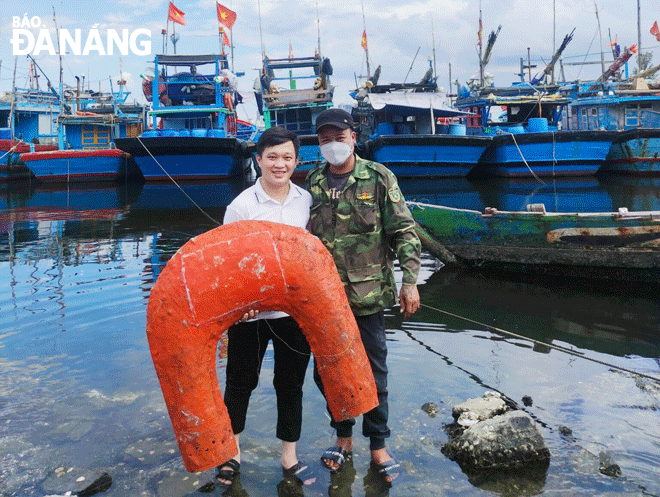Da Nang students create automatic lifebuoy
A group of students at the University of Education and Technology, a member school of the University of Da Nang (UD), successfully created the device ‘Automatic proactive search lifebuoy’. This is a product capable of proactively detecting, locating, and rescuing with a bracelet that integrates pressure sensors, GPS, and a buoy design that can maneuver to move to people in distress.
 |
| Student Tran Van Phuc (left) from the University of Education and Technology tests the product at the Tho Quang fishing wharf. Photo: VAN HOANG |
According to student Tran Van Phuc, the head of the research team, the need to use rescue equipment such as life jackets, buoys, air bags among people and tourists is very common. However, these devices share the same disadvantages.
They are still passive, have low rescue range, and are not optimal between effectiveness, comfort and cost.
Fully aware of this fact, Phuc, along with Dang Thanh Son and Nguyen Quang Vinh, students of the Faculty of Electrical and Electronics Engineering, the University of Education and Technology, researched and manufactured the automated lifebuoy according to standards under the SOLAS Convention (Safety of Life at Sea).
It has the ability to detect early, proactively search and rescue when drowning accidents occur, ensure the requirements for effectiveness and efficiency and overcome many limitations.
The device set includes two components: the buoy and the smart bracelet. In particular, the buoy shell is made up of many layers of glass fibers, polyester resin and catalyst, designed in a horseshoe shape (U-shaped) and can be hung outside the hull, side of the boat anchored with an electronic latch.
In the buoy, algorithms are used to position and move, navigating by GPS through 4 satellites. This is also the most important part for the life buoy to be automatic.
Accordingly, the device's hardware uses the Arduino platform, a powerful electronic development and programming platform developed based on open source principles, providing the ability to communicate with modules and external sensors via I/O pins. This allows the creation of devices and systems for automatic control, measurement, IoT (Internet of Things), robotics and many other innovative applications. The research team used the Uno board to control the buoy and the mini board to control the bracelet.
It is known that the bracelet uses small components, optimizing energy with a battery life of 2 months per charge. The bracelet is capable of detecting objects falling into the water with integrated sensors, self-locating, transmitting emergency signals and location information to buoys via radio waves. When the victim falls into the water, the bracelet sends a rescue signal to the buoy. After receiving the signal, the buoy automatically unlatches and moves to the victim's position and stops in place to wait for rescue. “In addition, we also designed a management application that tracks all lifebuoy information such as buoy status, battery life and system parameters, thereby helping the device to always be ready to operate ffectively," Phuc shared.
To evaluate the performance of the device, team members tested it in the waters off Son Tra and Tho Quang fishing wharf. According to Dang Thanh Son, in conditions of small waves and wind blowing from the sea to the shore, buoys starting from close to the shore can reach locations within a radius of about 180m within two minutes. However, when tested in an environment with high winds and large waves, some factors such as currents, weather and ocean waves affect the rescue speed.
On the other hand, the device's working area is limited to a 2km radius. This is also the biggest limitation that the team is improving so that the product can become standard rescue equipment on boats and control areas. Through an overall assessment, the system operates stably, with an average response speed of about four seconds, accurate positioning and the building of rescue paths and a buoy approach radius of 0.3-1.5m.
It is known that the device ‘Automatic lifebuoy with proactive search’ won a second prize in the university-level scientific research contest and took a berth in the top 15 of the 2023 ‘Technology startup among students’ contest organised by the University of Da Nang. The final round of the contest is scheduled to take place on November 11.
In addition, the project also entered the top 12 finals of the Viet Nam Social Innovation Challenge 2023 (VSIC 2023) with the theme ‘Startup towards sustainable development and focusing on social justice’ expected to take place at the end of November 2023.
Ph.D. Tran Hoang Vu, the Head of the Department of Electrical and Electronics Engineering, the University of Education and Technology, highly appreciated the group's idea. With a proactive, intelligent rescue solution, the product responds and develops towards AI (artificial intelligence).
However, the team needs to continue to develop and test elements such as identifying and avoiding obstacles during the rescue process and overcome disadvantages when used in different rescue environments.
The product is closely linked to the real practice, promoting rescue functions when an incident occurs. At the same time, it is also a topic for many students to consider and research to form ideas and create other useful products during the learning process.
“Projects need the cooperation from businesses to commercialise products. In the coming time, we will continue to encourage students to participate in scientific research movements, develop new startup models and projects., thereby promoting its role in training, consulting, and human resource development, contributing to building an innovative startup ecosystem in the city”, Vu said.
Reporting by VIET AN - Translating by A.THU